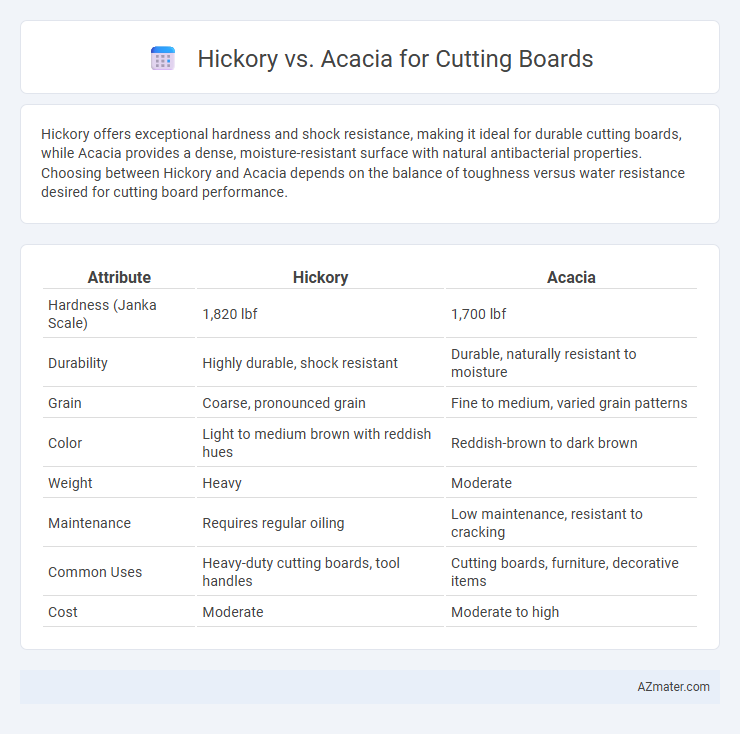Hickory offers exceptional hardness and shock resistance, making it ideal for durable cutting boards, while Acacia provides a dense, moisture-resistant surface with natural antibacterial properties. Choosing between Hickory and Acacia depends on the balance of toughness versus water resistance desired for cutting board performance.
Table of Comparison
| Attribute | Hickory | Acacia |
|---|---|---|
| Hardness (Janka Scale) | 1,820 lbf | 1,700 lbf |
| Durability | Highly durable, shock resistant | Durable, naturally resistant to moisture |
| Grain | Coarse, pronounced grain | Fine to medium, varied grain patterns |
| Color | Light to medium brown with reddish hues | Reddish-brown to dark brown |
| Weight | Heavy | Moderate |
| Maintenance | Requires regular oiling | Low maintenance, resistant to cracking |
| Common Uses | Heavy-duty cutting boards, tool handles | Cutting boards, furniture, decorative items |
| Cost | Moderate | Moderate to high |
Introduction to Hickory and Acacia Cutting Boards
Hickory cutting boards are known for their exceptional hardness, durability, and resistance to knife marks, making them ideal for heavy-duty kitchen tasks. Acacia cutting boards offer a beautiful, rich grain pattern with natural antimicrobial properties, combining both aesthetics and functionality in food preparation. Both woods provide sturdy, long-lasting surfaces, but Hickory excels in toughness while Acacia stands out for its elegant appearance and water resistance.
Wood Origin and Botanical Background
Hickory, native to North America, belongs to the genus Carya and is renowned for its dense, shock-resistant hardwood qualities, making it ideal for durable cutting boards. Acacia originates from tropical and subtropical regions worldwide, mainly within the genus Acacia, known for its rich, oily grain that offers natural resistance to moisture and bacteria. Both woods derive from distinct botanical families--Juglandaceae for Hickory and Fabaceae for Acacia--impacting their texture, hardness, and maintenance requirements in kitchen use.
Durability and Hardness Comparison
Hickory exhibits exceptional hardness with a Janka rating of 1,820, making it highly resistant to dents and scratches on cutting boards. Acacia, with a Janka hardness around 1,700, offers substantial durability but is slightly softer than Hickory, which may result in faster wear over time. Both woods provide strong resistance to knife marks, but Hickory's superior hardness ensures longer-lasting performance in heavy-use kitchen environments.
Grain Patterns and Aesthetic Differences
Hickory cutting boards feature a bold, contrasting grain pattern with a mix of dark and light streaks, creating a rustic, rugged aesthetic that emphasizes natural variations in wood. Acacia boards showcase a smoother, more uniform grain with rich, warm tones ranging from golden to deep reddish-brown, offering an elegant and polished appearance. The unique grain patterns in hickory contribute to a striking, dynamic look, while acacia provides a consistent and refined visual appeal ideal for modern kitchen designs.
Resistance to Moisture and Warping
Hickory offers superior resistance to moisture and warping due to its dense grain structure, making it a durable choice for cutting boards in wet conditions. Acacia, while also water-resistant, has a more varied grain pattern that can be prone to warping if not properly maintained with regular oiling. Both woods require care, but hickory generally provides enhanced stability and longevity in moisture-prone environments.
Impact on Knife Edges
Hickory cutting boards are known for their durability and dense grain, which offers a sturdy surface that minimally dulls knife edges over time. Acacia, with its tighter grain and slightly softer hardness, provides a more forgiving surface that reduces the risk of chipping and helps maintain sharper knife edges longer. Both woods are hardwoods suitable for cutting boards, but Acacia's balance of hardness and smooth grain makes it particularly beneficial for preserving blade sharpness.
Maintenance and Care Requirements
Hickory cutting boards require regular oiling with food-safe mineral oil to prevent drying and cracking, and occasional sanding may be needed to maintain a smooth surface. Acacia boards are naturally more water-resistant and dense, needing less frequent oiling but still benefit from periodic conditioning to preserve their finish and prevent warping. Both woods should be hand-washed promptly and dried thoroughly to extend their lifespan and maintain their durability in kitchen use.
Price and Availability
Hickory cutting boards generally offer a more affordable price point compared to Acacia, making them a budget-friendly option for many consumers. Acacia boards often come with a higher price due to their hardwood durability and attractive grain patterns, which also affects their availability in specialty kitchen stores. Both types are widely available online, but Hickory boards tend to have greater stock and variety due to their popularity and cost-effectiveness.
Eco-Friendliness and Sustainability
Hickory and Acacia cutting boards both offer sustainable qualities, but Hickory is often considered more eco-friendly due to its faster growth rate and local availability in many regions, reducing transportation emissions. Acacia wood is naturally durable and sourced from fast-growing tropical trees, but harvesting practices vary, impacting sustainability depending on certification like FSC. Choosing FSC-certified wood for either type ensures responsible forestry management and contributes to long-term ecological balance.
Which Wood is Best for Cutting Boards?
Acacia and hickory are both popular choices for cutting boards due to their durability and hardness, but acacia is often preferred for its higher resistance to water and fewer pores, which reduces bacterial absorption. Hickory offers exceptional toughness and impact resistance but can be more prone to warping and retains moisture longer than acacia. Therefore, acacia is generally considered the best wood for cutting boards when prioritizing hygiene and maintenance.

Infographic: Hickory vs Acacia for Cutting Board
 azmater.com
azmater.com